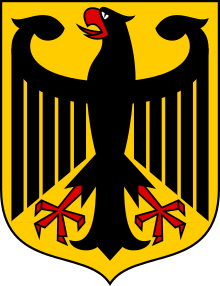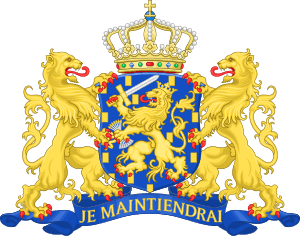Germany–Netherlands relations
 | |
Germany |
Netherlands |
|---|---|
| Diplomatic Mission | |
| Embassy of Germany, The Hague | Embassy of the Netherlands, Berlin |
| Envoy | |
| Ambassador Franz Josef Kremp[1] | Ambassador Monique van Daalen[2] |

German–Dutch relations refer to interstate relations between Germany and the Netherlands. Relations between the modern states started after 1871, even though the German people and Dutch people have had centuries of interactions. Both countries have had their respective territories governed by various states such as the Western Roman Empire, the Frankish Empire, and the Holy Roman Empire. An important factor in Dutch-German relations is the fact that William the Silent, Prince of Orange - leader of the Dutch Revolt and Vader des Vaderland of the Netherlands - belonged to the German House of Nassau.
In addition, both the Dutch and German languages are West Germanic languages. The English exonym for the Dutch people and language and the German endonym for their own language and people - Deutsch - share a common etymology, as both are derived from the word "Theodiscus", meaning "of the people".
History
During World War I, the German army refrained from attacking the Netherlands, and thus relations between the two states were preserved. At war's end in 1918, the former Kaiser Wilhelm II fled to the Netherlands, where he lived till his death in 1941. The German army occupied the Netherlands during World War II and kept the country under occupation in 1940–1945. Adolf Hitler had considered the Netherlands and its fellow Low Countries suitable for the Greater Germanic Reich due to their shared roots with Germans. During this period, nearly three-quarters of the Dutch Jewish population perished in the Holocaust.[3]
Present
Germany has an embassy in The Hague and consuls in Amsterdam, Arnhem, Eindhoven, Enschede, Groningen, Leeuwarden, Maastricht, Noord-Beveland, Rotterdam, while the Netherlands has an embassy in Berlin and consuls in Düsseldorf, Frankfurt, Hamburg, Munich and Stuttgart. Both nations are members of the European Union and NATO.
According to the official website of the Dutch government, relations between the two are currently "excellent", enjoying "close political, economic, social, cultural, administrative and personal ties". Germany is also by far the Netherlands’ main trading partner, both in imports and exports.[4]
Emigration
Around 164,000 Dutch people currently reside in Germany.
Country comparison
| Coat of Arms |  |
 |
| Flag |  |
 |
| Population | 82,800,000 | 17,237,700 [5] |
| Area | 357,168 km² (137,847 sq mi) | 41,543 km² (16,033 sq mi) |
| Population density | 232/km² (601/sq mi) | 415.1/km² (1,075.1/sq mi) |
| Capital | Berlin | Amsterdam (capital), The Hague (seat of government) |
| Largest city | Berlin – 3,690,000 (6,004,857 Metro) | Amsterdam – 851,573 (2,431,000 Metro) |
| Government | Federal parliamentary republic | Unitary parliamentary constitutional monarchy |
| First Leader | Konrad Adenauer | William I of the Netherlands (monarch), Gerrit Schimmelpenninck (prime minister) |
| Current Leader | Angela Merkel | Willem-Alexander (monarch), Mark Rutte (prime minister) |
| Official languages | German (de facto and de jure) | Dutch |
| Main religions | 57.9% Christianity, 36.2% non-religious, 4.9% Islam, 1.0% other[6] | 50.1% unaffiliated, 23.7% Roman Catholic, 6.5% Dutch Reformed Church, 5.7% Protestant Church in the Netherlands, 3.3% Reformed Churches in the Netherlands, 4.9% Islam, 4.6% other, 0.6% Hinduism, 0.4% Buddhism, 0.1% Judaism [7][8] |
| Ethnic groups | 81.3% German, 3.4% Turkish, 2.3% Polish, 1.5% Russian, 11.5% other | 79.3% Dutch, 6.3% other European, 4.9% Indo, 2.4% Turkish, 2.2% Moroccan-Dutch, 2.1% Surinamese, 0.9% Caribbean, 0.3% Chinese, 0.3% Iraqi, 3.9% other |
| GDP (nominal) | $3.65 trillion[9] | $945.327 billion [10] |
References
- ↑ Ambassadeur (in Dutch), Embassy of Germany, The Hague. Retrieved 30 December 2015.
- ↑ Ambassadeur (in Dutch), Embassy of the Netherlands, Berlin. Retrieved 30 December 2015.
- ↑ https://www.dw.com/en/ups-and-downs-between-germany-and-the-netherlands/a-15926992
- ↑ [https://www.government.nl/topics/international-relations/contents/germany
- ↑ "Population counter". Centraal Bureau voor de Statistiek. 2017. Retrieved 17 February 2018.
- ↑ Numbers and Facts about Church Life in Germany 2016 Report. Evangelical Church of Germany. Retrieved 14 June 2017.
- ↑ Schmeets, Hans (2016). De religieuze kaart van Nederland, 2010–2015 (PDF). Centraal Bureau voor der Statistiek. p. 5.
- ↑ CBS. "Helft Nederlanders is kerkelijk of religieus". www.cbs.nl (in Dutch). Retrieved 2017-10-17.
- ↑ http://www.imf.org/external/pubs/ft/weo/2017/02/weodata/weorept.aspx?pr.x=32&pr.y=19&sy=2015&ey=2016&scsm=1&ssd=1&sort=country&ds=.&br=1&c=512%2C672%2C914%2C946%2C612%2C137%2C614%2C546%2C311%2C962%2C213%2C674%2C911%2C676%2C193%2C548%2C122%2C556%2C912%2C678%2C313%2C181%2C419%2C867%2C513%2C682%2C316%2C684%2C913%2C273%2C124%2C868%2C339%2C921%2C638%2C948%2C514%2C943%2C218%2C686%2C963%2C688%2C616%2C518%2C223%2C728%2C516%2C558%2C918%2C138%2C748%2C196%2C618%2C278%2C624%2C692%2C522%2C694%2C622%2C142%2C156%2C449%2C626%2C564%2C628%2C565%2C228%2C283%2C924%2C853%2C233%2C288%2C632%2C293%2C636%2C566%2C634%2C964%2C238%2C182%2C662%2C359%2C960%2C453%2C423%2C968%2C935%2C922%2C128%2C714%2C611%2C862%2C321%2C135%2C243%2C716%2C248%2C456%2C469%2C722%2C253%2C942%2C642%2C718%2C643%2C724%2C939%2C576%2C644%2C936%2C819%2C961%2C172%2C813%2C132%2C199%2C646%2C733%2C648%2C184%2C915%2C524%2C134%2C361%2C652%2C362%2C174%2C364%2C328%2C732%2C258%2C366%2C656%2C734%2C654%2C144%2C336%2C146%2C263%2C463%2C268%2C528%2C532%2C923%2C944%2C738%2C176%2C578%2C534%2C537%2C536%2C742%2C429%2C866%2C433%2C369%2C178%2C744%2C436%2C186%2C136%2C925%2C343%2C869%2C158%2C746%2C439%2C926%2C916%2C466%2C664%2C112%2C826%2C111%2C542%2C298%2C967%2C927%2C443%2C846%2C917%2C299%2C544%2C582%2C941%2C474%2C446%2C754%2C666%2C698%2C668&s=NGDPD&grp=0&a=
- ↑ "Netherlands". International Monetary Fund. April 2018. ,